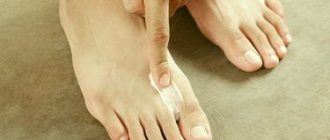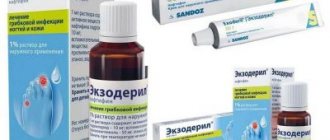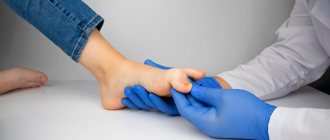Amorolfine nail polish 5% bottle 2.5 ml (Tula Pharmaceutical Factory)
Registration Certificate Holder
TULA PHARMACEUTICAL FACTORY (Russia)
Dosage form
Medicine - Amorolfine
Description
Medicinal nail polish
in the form of a transparent liquid from colorless to light yellow.
1 ml
amorolfine hydrochloride 55.7 mg, which corresponds to the content of amorolfine 50 mg
Excipients
: triacetin - 10.5 mg, ammonium methacrylate copolymer (type A) - 125 mg, ethyl acetate - 150 mg, butyl acetate - 50 mg, ethanol 95% - up to 1 ml.
0.5 ml - bottles (1) - cardboard packs. 1 ml - bottles (1) - cardboard packs. 1.5 ml - bottles (1) - cardboard packs. 2 ml - bottles (1) - cardboard packs. 2.5 ml - bottles (1) - cardboard packs. 3 ml - bottles (1) - cardboard packs. 3.5 ml - bottles (1) - cardboard packs. 4 ml - bottles (1) - cardboard packs. 4.5 ml - bottles (1) - cardboard packs. 5 ml - bottles (1) - cardboard packs. 6 ml - bottles (1) - cardboard packs. 7 ml - bottles (1) - cardboard packs. 8 ml - bottles (1) - cardboard packs. 9 ml - bottles (1) - cardboard packs. 10 ml - bottles (1) - cardboard packs.
Indications
Onychomycosis caused by dermatophytes, yeast and mold fungi (if no more than 2/3 of the nail plate is affected). Prevention of fungal nail infections.
Contraindications for use
Newborn period and early childhood, pregnancy, lactation, hypersensitivity to amorolfine.
pharmachologic effect
Antifungal agent for external use. It has fungistatic and fungicidal effects. Damages the cell membrane of fungi, mainly due to disruption of sterol synthesis. Reduces ergosterol content and causes the accumulation of abnormal non-planar stereoisomers of sterols. Active against yeast fungi of the genus Candida spp., Pityrosporum spp., Malassezia spp., Cryptococcus spp., dermatophytes (Trichophyton spp., Microsporum spp., Epidermophyton spp.), molds (Altemaria, Hendersonula, Scopulariopsis), Dematiaceae fungi ( Cladosporium, Fonsecaea, Wangiella), dimorphic fungi (Coccidioides, Histoplasma spp., Sporothrix) and actinomycetes.
Dosage regimen
Apply externally. The dose and duration of treatment depend on the indications and dosage form used.
Side effect
Local reactions:
burning, hyperemia, itching.
special instructions
It is not recommended to use cosmetic nail polish or false nails during treatment. Impermeable gloves should be worn when working with organic solvents. Files used on affected nails should not be used on healthy nails.
Use during pregnancy and breastfeeding
Restrictions during pregnancy - Contraindicated. Restrictions when breastfeeding - Contraindicated.
Contraindicated: pregnancy, lactation period.
Use in children
Restrictions for children - Contraindicated.
Contraindicated: neonatal period and early childhood.
Amorolfine
Dosage form
Medicinal nail polish
Composition per 1 ml:
Active substance
: amorolfine hydrochloride (in terms of amorolfine 50 mg) – 55.7 mg.
Excipients: triacetin (glycerol triacetate) – 10.5 mg, methyl methacrylate, trimethylammonioethyl methacrylate chloride and ethyl acrylate copolymer [2:0.2:1] (ammonium methacrylate copolymer (Type A) (Eudragit RL 100)) – 125.0 mg, ethyl acetate – 150.0 mg, butyl acetate – 50.0 mg, ethanol 95% – up to 1 ml.
Description
Transparent liquid from colorless to light yellow.
Pharmacotherapeutic group
Antifungal agent.
ATX code
: D01AE16
Pharmacological properties
Antifungal drug for external use. It has a fungistatic and fungicidal effect due to damage to the cytoplasmic membrane of the fungus by disrupting the biosynthesis of sterols. Reduces the content of ergosterol, the content of atypical steric non-planar sterols accumulates.
Has a wide spectrum of action. Highly active against both the most common and rare pathogens of fungal nail infections:
Dermatophytes: Trichophyton spp., Microspomm spp., Epidamophytonjloccosum; Yeast fungi: Candida spp.
;
Molds: Alternaria spp., Scopulariopsis spp., Hende, sonula spp.
;
Fungi from the family Dematiaceae
:
Cladosporium spp.
;
Insensitive species: Aspergillus, Fusarium, Mucorales
.
Pharmacokinetics
When applied to nails, it penetrates into the nail plate and further into the nail bed, almost completely within the first 24 hours. The effective concentration remains in the affected nail plate for 7-10 days after the first application. Systemic absorption is negligible: plasma concentration is below the sensitivity limit of detection methods (less than 0.5 ng/ml).
Indications for use
Treatment of fungal nail infections caused by dermatophytes, yeasts and molds.
Prevention of fungal nail infections.
Contraindications
Hypersensitivity to amorolfine and other components.
Age up to 18 years.
Use during pregnancy and breastfeeding
The use of the drug during pregnancy and breastfeeding is not recommended.
Directions for use and doses
Externally. Apply to affected fingernails or toenails 1-2 times a week as follows:
- Before using Amorolfine varnish, it is necessary to remove as much of the affected nail as possible with scissors, and carefully treat the affected areas of the nail on its surface using the supplied nail file.
- Then clean the surface of the nail and degrease it with the supplied swab moistened with alcohol. Treatment of nails with a file and a swab with alcohol must be carried out before each use of the drug.
- Dip a spatula into the varnish. The spatula should be removed from the bottle without touching its neck; you should not wipe off excess varnish on the neck of the bottle.
- Apply the varnish to the entire surface of the affected nail using a spatula. Repeat the above procedure for each affected nail.
- Close the bottle of varnish tightly immediately after use to prevent it from drying out.
- After use, wipe the spatula with a swab. Throw away the used tampon.
- Allow the varnish to dry for approximately 3-5 minutes.
The above procedure should be carried out for each affected nail.
Before each subsequent application of Amorolfine, it is necessary to remove the previous layer of varnish with a swab, file the nails, and then clean and degrease the surface using a swab.
Treatment should be carried out continuously until the affected area is completely healed and the nail plate is regenerated.
If you forgot to apply varnish on the scheduled day, then it must be applied as soon as possible.
The duration of treatment is usually 6 months for fingernails and 9 to 12 months for toenails.
If there is no improvement within 3 months, it is recommended to consult a doctor.
Due to the slow growth of nail plates, the first signs of improvement may become noticeable only after 2-3 months of using the drug. If there are no signs of improvement after 3 months, or if symptoms worsen or new symptoms appear, you should consult your doctor. Use the drug only according to the indications, the method of use and in the doses indicated in the instructions for use.
Side effect
When using the drug Amorolfine, adverse reactions are rare. Damage to the nails, such as discoloration, destruction of the nail plates, brittle nails, can be a consequence of fungal nail infections.
Classification of adverse reactions by organs and systems, indicating the frequency of their occurrence: very often (> 1/10), often (> 1/100, < 1/10), infrequently (> 1/1000, < 1/100), rarely ( > 1/10000, < 1/1000), very rare (< 1/10000), including isolated reports, frequency unknown (frequency cannot be estimated based on available data).
Immune system disorders
, frequency unknown hypersensitivity reactions (systemic allergic reactions).
Skin and subcutaneous tissue disorders
: rarely damage to the nails, discoloration of the nails, onychoclasia (fragility of the nail plate), onychorrhexis (brittleness of the nail plate); very rarely - burning sensation of the skin; frequency unknown - erythema, itching, contact dermatitis, urticaria, blistering.
If you experience the side effects listed in the instructions, or they get worse, or you notice any other side effects not listed in the instructions, tell your doctor.
Overdose
When using the drug in accordance with the instructions for use, an overdose is unlikely. In case of accidental ingestion of the drug, rinse the stomach and, if necessary, carry out symptomatic therapy.
Interaction with other drugs
Not studied.
special instructions
— A file used to treat affected nails should not be used to treat healthy nails!
— During treatment, the use of false artificial nails should be avoided.
— Do not allow the varnish to get into your eyes, ears or mucous membranes.
— The napkin contains a highly flammable substance.
— Persons working with organic solvents (for example, paint thinners, gasoline, kerosene, etc.) should wear sealed gloves to protect nail polish.
— To prevent the varnish from drying out, close the lid tightly after use. To prevent the lid from sticking, avoid getting varnish on the threads.
— If you missed applying varnish, you should not apply an excessive amount of it in several layers; it is enough to continue treatment according to the instructions for use.
— Do not pour out the remaining drug in a place where water or household waste is drained.
— Patients with conditions predisposing to the development of fungal nail infections (poor peripheral circulation, diabetes mellitus, immunodeficiency), as well as patients with nail dystrophy or a damaged nail plate, psoriasis or other chronic skin diseases, are advised to consult a doctor before using the drug.
If more than 2/3 of the nail plate is damaged or fungal, you should also consult a doctor to prescribe concomitant oral therapy. If systemic or local allergic reactions occur, you should immediately stop using Amorolfine varnish and consult a doctor. Using nail polish remover, you need to remove the product from your nails. The drug should not be reapplied. The product contains ethanol, so applying it too often or incorrectly can lead to irritation or dryness of the skin around the nail. The tampon contains a highly flammable substance.
Impact on the ability to drive vehicles and machinery
Not studied.
Release form
Medicinal nail polish 5%.
0.5 each; 1; 1.5; 2; 2.5; 3; 3.5; 4; 4.5; 5; 6; 7; 8; 9; 10 ml in a brown glass bottle with LDPE stopper and screw cap.
1 bottle of the drug, 6 applicators with polypropylene blades, 12 nail files wrapped in a plastic bag, 12 sachets with cleaning swabs are placed in a polypropylene container, which, together with instructions for medical use, is placed in a cardboard pack.
Storage conditions
Store in a place protected from light at a temperature not exceeding 25 °C.
Keep out of the reach of children.
Best before date
2 years.
Do not use after expiration date.
Vacation conditions
Available without a prescription.
Reviews
Reviews of Amorolfine nail polish:
- “... After visiting the hospital, I noticed that I had fungus on my nails, they started treating me with ointments, but they seemed ineffective to me. But this varnish helped a lot, I applied it once every 7 days, a year has already passed, and there is no trace of fungus on my nails”;
- “... I’ve been treating fungus with this remedy for several months now, if you follow the recommendations in the instructions, the drug is quite effective. I use the polish once every 3 days. I’m happy with everything so far”;
- “... This remedy did not help me; the fungus grew as it wanted with or without it. Two nails were affected and had to be treated with folk remedies”;
- “... The varnish seems to help if you apply it regularly, but the price doesn’t suit me. I wish I could find something cheaper.”
Pharmacodynamics and pharmacokinetics
This substance inhibits the activity of enzymes that take part in the processes of sterol in fungal cells. Amorolfine inhibits the enzymes delta-14-reductase and delta-7–8 isomerase , significantly reduces the concentration of ergosterol , which leads to the accumulation of abnormal stereoisomers of sterols in cells. Under the influence of the drug, the structure of the fungal cell membrane is disrupted. Depending on the dosage used, the product may have a fungicidal or fungistatic effect.
The substance exhibits activity against fungi of the genus Candida, Cryptococcus and Malassezia; to dermatophytes Microsporum, Trichophyton and Epidermophyton; molds Scopulariopsis, Alternaria and Hendersonula; dimorphic fungi Histoplasma, Coccidioides and Sporothrix; actinomycetes, Dematiaceae fungi.
Most often, the medicine is used in the form of nail polish. After application to the surface of the nail, the product easily and deeply penetrates the nail plate and nail bed. Has a low degree of systemic absorption.
Drugs containing (Analogs)
Level 4 ATC code matches: Myconorm
Undecin
Gentian violet
Zinkundan
Exoderil
Exiter
Batrafen
Lotseril
Lamisil Dermgel
Lamisil Uno
Lamisil
Salicylic acid
Salicylic ointment
Keto Plus
Exifin
Fungoterbin
Mycoseptin
Thermikon
Nitrofungin
Sulsena
Trade names of the product: Oflomil Lak , Lakomik , Lotseril , Onyhell .





